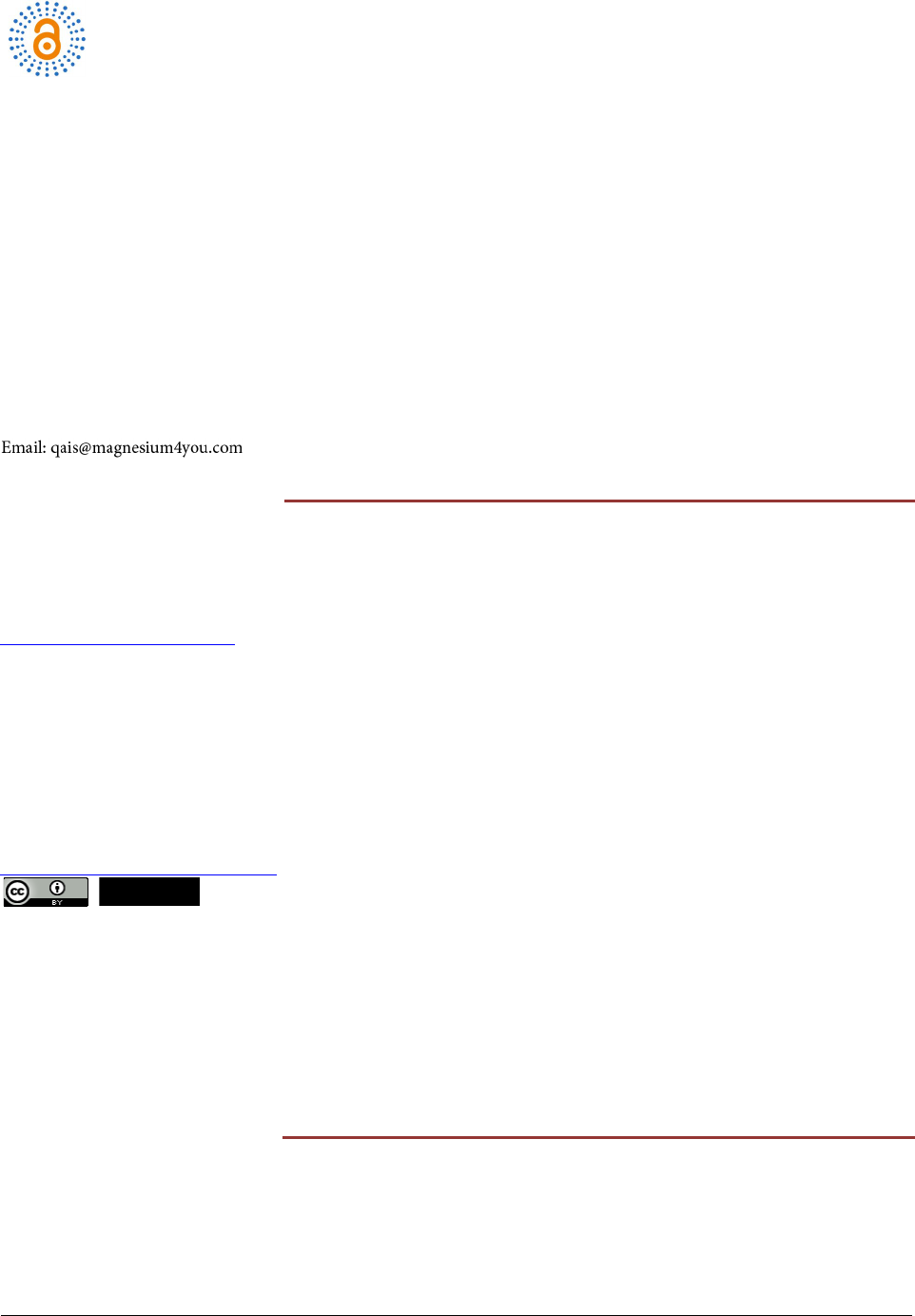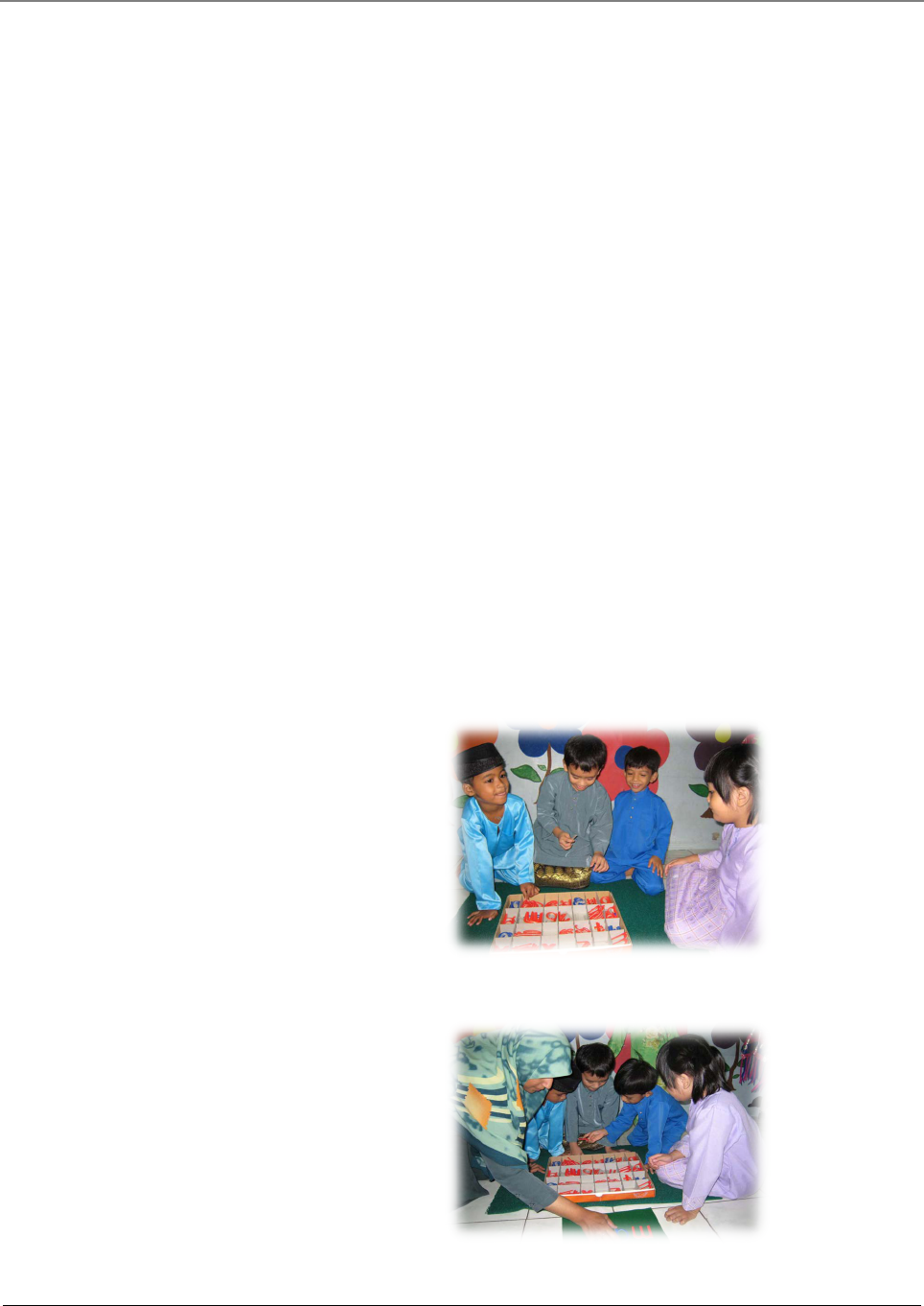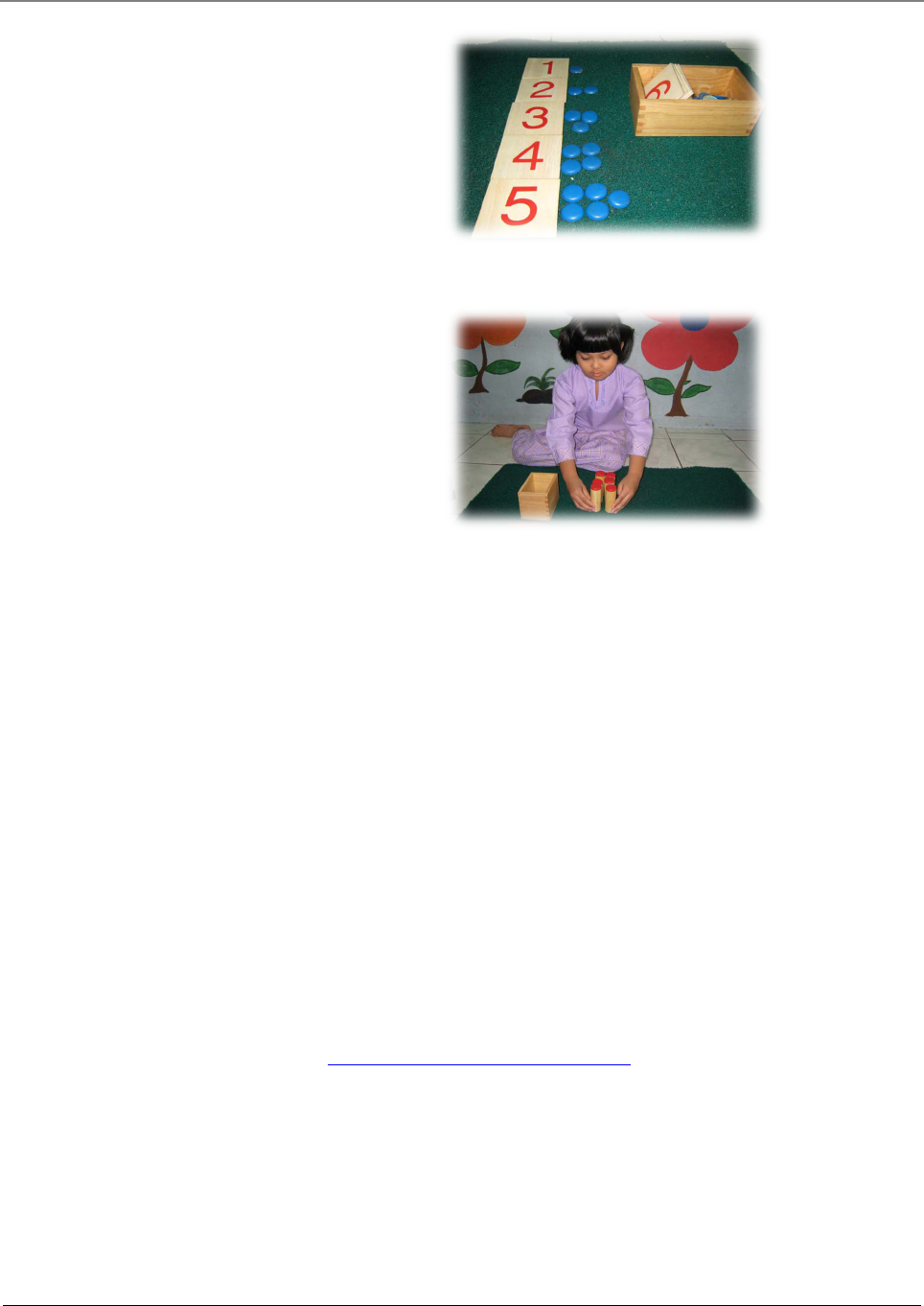
Open Access Library Journal
2017, Volume 4, e4140
ISSN Online: 2333-9721
ISSN Print: 2333-9705
DOI:
10.4236/oalib.1104140 Nov. 30, 2017 1 Open Access Library Journal
The Application of Montessori Method in
Learning Mathematics: An Experimental
Research
Qais Faryadi
Future Expert Solutions, Kuala Lumpur, Malaysia
Abstract
The prime objective of this research was to investigate whether the Montessori
method of learning helped kindergarten pupils improve their
mathematical
proficiency, critical thinking and problem-solving skills, besides training
them
to be responsible learners. Quantitative, qualitative, and observational met
h-
ods were employed in the investigation.
The sample for the study comprised
180 kindergarten pupils from
TadikaBestari Al-Hidayah
,
located in Bandar
Seri Damansara, Malaysia. The instruments for collecting data were que
s-
tionnaires, interviews, and field observations. Results from a pre-
test and a
post-test showed that pupils who used the Montessori method,
i.e
. the e
x-
perimental group, outperformed (72.2% passed) their peers who were not e
x-
posed to the Montessori method (39% passed).
The findings indicated that the
Montessori method
indeed helped learners to improve their mathematical
proficiency. This research offers guidelines to future researchers on alternative
learning methods, especially for very young children. The findings of this e
m-
pirical research could be prototyped for learning other subjects.
Subject Areas
Education
Keywords
Montessori, Learning, Teaching, Sensory, Critical Thinking, Mathematics
1. Introduction
The Montessori Method of learning was developed by Dr. Maria Montessori
from Italy (trilliummontessori.org, 2017). A medical doctor, she developed a
How to cite this paper:
Faryadi, Q. (2017
)
The Application of Montessori Method in
Learning Mathematics: An Experimental
Research
.
Open Access Library Journal
,
4
:
e4140
.
https:
//doi.org/10.4236/oalib.1104140
Received:
November 10, 2017
Accepted:
November 27, 2017
Published:
November 30, 2017
Copyright © 201
7 by author and Open
Access Library Inc
.
This work is licensed under the Creative
Commons Attribution International
License (CC BY
4.0).
http://creativecommons.org/licenses/by/4.0/
Open Access

Q. Faryadi
DOI:
10.4236/oalib.1104140 2 Open Access Library Journal
very keen interest to help mentally ill and retarded children learn. Montessori
strongly believed that learners could teach themselves. Thus, she developed the
Montessori method of learning, regarded by scholars and educationists as
unique, effective, and efficient. According to study, intervention by adults in
times of need effectively helps learners to learn and progress noticeably [1]. Dr.
Maria Montessori believed that each learner is a unique being, and he/she can
surprise us with unique talents [2]. The theory of Montessori learning is simple.
Students learn by playing. Playing is not in the literal meaning, but pretended
playing. Today in this age of technology, many researchers believe that students
should learn constructively and enjoyably. This type of learning is indeed flexi-
ble, active, constructive and fun. The Theory of Montessori learning is based on
guided learning using relevant toys that matches children’s age and capabilities.
In the meantime, an adult takes charge of the student and is ready to help if
needs arise. Montessori learning method is based on group learning. Similar age
groups are stationed to learn effectively. Montessori students consist of 3 to 12
years of age. The beauty of this methodology is that, materials are kept on the
shelves and freely available to the children. During the learning sessions, if a
student makes a mistake or has any problem, he/she can refer to the material as
a reference point.
2. Problem Statement
This research argues that the Montessori method of teaching helps students to
learn mathematics faster and improve their critical thinking and problem-solving
skills, as well as be responsible learners in the class.
3. Research Objectives
This research was aimed at achieving the following objectives:
1) To investigate whether learners improved their problem-solving skills and
critical thinking skills when they utilized the Montessori method of learning.
2) To investigate whether using the Montessori method of learning helped
learners to improve their mathematical proficiency.
3) To investigate whether learners become more disciplined and responsible
by using the Montessori method.
4. Research Questions
This research sought to answer the following questions:
1) Do learners improve their problem-solving skills and critical thinking skills
when they utilize the Montessori method?
2) Does the Montessori method help raise the level of mathematical profi-
ciency among the pupils?
3) Does the Montessori method assist learners to be more responsible pupils
in the class?

Q. Faryadi
DOI:
10.4236/oalib.1104140 3 Open Access Library Journal
5. Research Hypotheses
H
1
: Learners who utilize the Montessori method improve their prob-
lem-solving skills and critical thinking skills.
H
2
: Learners who utilize the Montessori method improve their mathematical
proficiency.
H
3
: The Montessori method of teaching assists learners to be responsible pu-
pils in the classroom.
6. Justification of the Research
1) The findings of this research would contribute to the development of a pa-
radigm of learning, namely the Montessori method of learning. The findings of
this empirical research could be prototyped for learning other subjects.
2) This study offers guidelines for the use of a more viable alternative to the
traditional methods of teaching mathematics in the Malaysian classroom.
3) Interviews, observations, questionnaires and field worksheets from this
study would provide valuable information for other researchers who wish to
teach mathematics using the Montessori method.
7. Literature Review
To fully develop the unseen potential of our learners, teachers must give them
freedom of choice to explore their environment. Instructors should develop the
concept of self-respect for their learners as well as train them to respect others
[3]. The Montessori Method of teaching concentrates on quality rather than
quantity. Teachers assist learners with the sensory-based teaching methodology
advocated by Maria Montessori [4]. In addition, it is important that pupils must
enjoy the process of learning. In other words, Montessori teachers adopt a holis-
tic approach to enable their pupils to learn more effectively. Every learner is
considered as an individual who must not be guided and controlled all the time
by an adult [5] [6].
“
Scientific observation has established that education is not
what the teacher gives
;
education is a natural process spontaneously carried out
by the human individual
,
and is acquired not by listening to words but by expe-
riences upon the environment
.
The task of the teacher becomes that of preparing
a series of motives of cultural activity
,
spread over a specially prepared environ-
ment
,
and then refraining from obtrusive interference
.
Human teachers can only
help the great work that is being done
,
as servants help the master
.
Doing so
,
they will be witnesses to the unfolding of the human soul and to the rising of a
New Man who will not be a victim of events
,
but will have the clarity of vision to
direct and shape the future of human society
”.
Maria Montessori,
Education for
a New World
:
Retrieved from
:
http://www.michaelolaf.net/maria.html, 2017.
In
Montessori learning, there is a sense of direction rather than forcing learners to
learn [7]. Effective learning happens when the learner’s senses are activated. Stu-
dies have found that 75% of learning occurs visually, while 13% occurs through
hearing and touching. Smell and taste account for 12%. So, if multi-senses are

Q. Faryadi
DOI:
10.4236/oalib.1104140 4 Open Access Library Journal
stimulated, more learning should take place. See Figure 1, it shows students are
learning together for collective achievement.
8. Sensory Method
The sensory learning programme is an innovative approach that unites three
modalities (visual, auditory and vestibular) into one intervention, thus allowing
individuals to merge sensory messages for perfect learning outcomes [8] [9].
According to researchers [10], we all learn differently using our dynamic cha-
racteristics. We have certain values attached to our learning styles. If we com-
bined all these attached values in cognitive and sensory learning styles, the
learning process would be facilitated [11].
Figure 2 below shows how sensory
learning method stimulates learner’s motivation.
8.1. Learning and the Mind
According to Shelly, our mind is like a locked playground. We have to unlock
that playground to achieve learning outcomes. So, by applying of all our senses,
it is possible to acquire the necessary skills to achieve academic excellence (Shel-
ly, 2002). Research confirms that sensory motor integration helps learners to
achieve success and acquire necessary skills. “
The Montessori method can be re-
cast as a viable contemporary
,
constructivist program for early childhood educa-
tion
.
Montessori believed that learners in the crucial years from birth to age six
possess extraordinary
,
innate mental powers to absorb the environment
” [12].
The Montessori approach is a unique methodology of teaching. It must be ap-
plied precisely for a positive outcome. A study by [13] found that Montessori
Figure 1. Learning together.
Figure 2. Sensory learning.

Q. Faryadi
DOI:
10.4236/oalib.1104140 5 Open Access Library Journal
learners performed better compared to those studying in public and private
schools which did not adopt the Montessori approach in the classroom. See be-
low
Figure 3. Students learn by thinking critically for a perfect outcome.
8.2. The Instructor’s Role
In the Montessori approach to learning, there is a link between instructors and
parents [14]. To learn effectively, Maria Montessori insisted that learners, teach-
ers and parents must co-operate with one another so that young children can
learn more effectively. In cooperative learning environment size does not matter,
even a single student learns cooperatively. As thus the important of cooperative
learning is evident even with one student [15]. Although Piaget and Vygotsky
had much respect for Dr. Montessori, they were not happy with her emphasis on
a sensorial approach to education. Nevertheless, they utilized the Montessori
method as a bridge for constructive accomplishment [16]. In the Montessori
class, learners work hands-on and they actually experience the satisfaction of
accomplishing a given task. In other words, according to Montessori, the hands
play an important role in contributing to the learner’s education [17] [18]. As it
shown in
Figure 4, the teacher is helping the students who are in need. It is
called (ZPD).
8.3. The Role of Needs
The Montessori methodology of learning emphasizes the developmental needs
of learners. One of the most outstanding objectives of Montessori teaching is to
Figure 3. Doing by thinking.
Figure 4. The role of instructor.

Q. Faryadi
DOI:
10.4236/oalib.1104140 6 Open Access Library Journal
foster competency and a sense of responsibility in the mind of young learners. In
the Montessori classroom, everybody has a role to play. The teacher is commit-
ted to creating clear instructions to prepare pupils for the learning process in a
specific environment. So, students do not need expert teachers to guide them all
the way to achieve success. Role playing is thus an important pedagogical me-
thodology of learning. [19]. The learner’s prerequisite is engagement in a mea-
ningful activity that enriches them physically and intellectually. Researchers
agree that social-historical activity (play) theory can motivate learners to engage
in the class and learn effectively [20]. Studies indicate that the success of the
Montessori methodology is based on respect and individualistic attention given
to the learners. Montessori instructors create an environment that is conducive
for learning and let learners strive for excellence at their own pace. As thus
creating environment that is conducive and encouraging [21]. The Montessori
methodology emphasizes that learners should be given an opportunity to choose
their own material for reading and learning. This personal autonomy helps them
in the problem-solving process [22].
9. Four Crucial Principles of the Montessori Method
Self-Respect
Develop self-respect for the learners.
Take the opportunity to educate yourself.
Respect teachers and adults.
Contribution with good intention.
Develop love for learning.
Be a responsible student.
Consider knowledge as a source of great pleasure.
Appreciate the fact that learners are born with unseen talents.
9.1. Teaching
Cognitive and sensory learning is important.
We should unlock the learner’s mind.
Mental power is critical.
Early childhood education is crucial.
9.2. Theory
Learning is acquired through exploration.
The environment is the key to learning.
Sensory-based learning methods are preferred.
Stimulation of senses is the key to learning.
9.3. Students
They learn stylishly and innovatively.
Each learner is a unique being.

Q. Faryadi
DOI:
10.4236/oalib.1104140 7 Open Access Library Journal
Learners have freedom of choice.
Each learner learns differently.
Learners have attached values.
10. Critics of Montessori Learning
Although Maria Montessori devoted much of her life to educating children, her
critics argue that her theory of learning has created many problems for learners.
The Montessori approach has been criticized for giving too much freedom to
young learners and leaving them in the classroom without proper supervision.
As a result, children often fight among themselves rather than engage in learning
tasks. Older learners naturally suppress the younger ones for supremacy and
above all for the possession of their favorite toys. In a Montessori classroom,
learners are often not friendly or rule abiding learners. They break every rule to
be the winner in the class.
There is no creativity as well as interaction among the learners [23]. In fact,
the effectiveness of the Montessori theory is not really proven and studies sug-
gest that the measurement of sensory approach to learning outcome is unsatis-
factory [24] [25]. From Dewey’s point of view, the Montessori approach does
not encourage creativity and the classroom is not adequately stimulating. Be-
sides, Montessori’s teaching materials are very expensive and highly specialized;
most parents cannot afford to purchase them for their children to practise at
home. Moreover, the Montessori concept of childevaluationhas been criticized
for being poor and unsystematic. Progress is recorded in report cards, making it
difficult to assess accurately the learners’ success or failure [26]. Eye witnesses
have expressed shock at the way learners are allowed to roam around in a Mon-
tessori compound: “
Everything about it seems a little off
.
I mean
,
they got kids
playing out on the playground at all times of the day
.
And scraping away on
those weird Mexican gourds
.
What kind of school is that
?”
Kramarczyk asked
.
“
And the teachers have always got the kids doing these weird little puppet shows
.
That
’
s gotta tell you something right there
”. But however, the Montessori learn-
ing methodology is still relevant and its socially rich environment is mind blow-
ing [27].
11. Methodology
In this research, qualitative, quantitative and observation methods of data collec-
tion were used. The qualitative method was used to collect and analyze data
while the quantitative method was used to strengthen the qualitative data. The
independent variable in this research was the Montessori method of instruction.
The dependent variables were the learners’ problem-solving skills, critical
thinking skills, and students’ behavioral changes. The instruments used to collect
data were 1) pre-test and post-test, 2) field observation of learners’ facial expres-
sion, satisfaction, and motivation in the classroom, 3) questionnaires, interviews,
and participants’ opinions. One day before the commencement of the experi-

Q. Faryadi
DOI:
10.4236/oalib.1104140 8 Open Access Library Journal
mentation, the researcher administered a pre-test to evaluate the pupils’ profi-
ciency in mathematics. A post-test was conducted after a lapse of four months
during which the experimental group utilized the Montessori method of learn-
ing mathematics.
12. Results
180 students participated in this study. Based on the interviews, questionnaires
and special pre- and post-tests, the majority of the pupils in the experimental
group were of the view (
interview
) that the Montessori method helped them to
improve their mathematical proficiency, critical thinking skills, problem solving
skills and they were disciplined in the class.
13. Control Group
PRE-TEST:
Students were given a general test about counting, critical thinking and prob-
lem solving. The purpose of the test was to gauge their basic knowledge in ma-
thematics. After the pre-test, they were taught in the traditional manner using a
chapter of the kindergarten syllabus for four months without any intervention.
The following are the test scores in the pre-test:
Final scores combined for all three categories (
mathematical assessment
)
(
critical thinking
,
problem solving
,
and discipline
)
Pass Marks
Critical thinking: 30 MARKS N = 20/90 pass (22.3% pass)
Problem solving: 30 MARKS N = 25/90 pass (27.8% pass)
Discipline: 40 MARKS N = 35/90 pass (38.9% pass)
Total: 29.6%
Fail Marks
Critical thinking: 30 MARKS N = 70/90 fail (77.8% fail)
Problem solving: 30 MARKS N = 65/90 fail (72.3% fail)
Discipline: 40 MARKS N = 55/90 fail (61.2% fail)
Total: 72.4%
POST-TEST:
After four months, students were given a post-test that assessed skills in criti-
cal thinking and problem solving. Their discipline in class was also noted. The
following are the post-test scores: Final scores combined for all three Categories
(
mathematical assessment
) (
critical thinking
,
problem solving and discipline
)
Pass Marks
Critical thinking: 30 MARKS N = 55/90 pass (61.2% pass)
Problem solving: 30 MARKS N = 60/90 pass (66.7% pass)
Discipline: 40 MARKS N = 65/90 pass (72.2% pass)
Total: 66.7%

Q. Faryadi
DOI:
10.4236/oalib.1104140 9 Open Access Library Journal
Fail Marks
Critical thinking: 30 MARKS N = 35/90 fail (38.9% fail)
Problem solving: 30 MARKS N = 30/90 fail (33.4% fail)
Discipline: 40 MARKS N = 25/90 fail (27.8% fail)
Total: 33.4%
14. Experimental Group
PRE-TEST:
Students were given the same test as that for the control group. Similarly, the
purpose of the test was to assess their basic knowledge in mathematics. The fol-
lowing are the test scores in the pre-test: Final scores combined for all three
Categories: (
mathematical assessment
) (
critical thinking
,
problem solving and
discipline
)
Pass Marks
Critical thinking: 30 MARKS N = 35/90 pass (38.9% pass)
Problem solving: 30 MARKS N = 35/90 pass (38.9% pass)
Discipline: 40 MARKS N = 20/90 pass (22.3% pass)
Total: 33.6%
Fail Marks
Critical thinking: 30 MARKS N = 55/90 fail (61.2% fail)
Problem solving: 30 MARKS N = 55/90 fail (61.2% fail)
Discipline: 40 MARKS N = 65/90 fail (72.3.% fail)
Total: 64.9%
POST-TEST:
The participants in the control group were taught the same chapter of the
kindergarten syllabus as that used by teachers in the control group. However, the
teachers used the Montessori method for the control group for the same dura-
tion,
i.e
. four months. The following are the test scores in the post-test: Final
scores combined for all three Categories: (
mathematical assessment
) (
critical
thinking
,
problem solving and discipline
).
Pass Marks
Critical thinking: 30 MARKS N = 75/90 pass (83.4% pass)
Problem solving: 30 MARKS N = 70/90 pass (77.8% pass)
Discipline: 40 MARKS N = 70/90 pass (77.8% pass)
Total: 79.7%
Fail Marks
Critical thinking: 30 MARKS N = 15/90 fail (16.7% fail)
Problem solving: 30 MARKS N = 20/90 fail (22.3% fail)
Discipline: 40 MARKS N = 20/90 fail (22. 3% fail)
Total: 20.5%
As apparent from the scores of the Post-test for the experimental group, pu-

Q. Faryadi
DOI:
10.4236/oalib.1104140 10 Open Access Library Journal
pils who utilized the Montessori learning method (79.7% pass/20.5% fail) out-
performed their peers who did not use the Montessori method of learning
(66.7% pass/33.4% fail) in all the three categories (
Table 1) (
critical thinking
,
problem solving and discipline
).
15. Hypothesis Testing
15.1. Hypothesis One
Effect of Montessori Learning on Thinking Skills
Instructors who use the Montessori approach view learners’ minds as a locked
playground that must be unlocked to achieve learning outcomes. The results of
the pre-test and post-test in this study indicated that the Montessori method in-
deed helped students to be more alert and improved their critical thinking skills.
Moreover, learners acquired the necessary skills to achieve academic excellence
in mathematics. The improved scores on the thinking skills aspect of the test
validated the hypothesis H
1
, that learners who utilized the Montessori method
improved their thinking skills.
15.2. Hypothesis Two
Effect of Montessori Learning on Problem-Solving Skills
Based on the Montessori approach, education is not what the teacher gives but is
a natural process spontaneously carried out by the individual, and learning is
acquired not by listening to words but by experiences in carrying out specific
tasks. In the Montessori environment, pupils are challenged with problems so
that they can think for themselves. Once they are given the opportunity to think
critically, new knowledge is created. The improved scores on the problem-solving
skills aspect of the test validated the hypothesis H
2
, that learners who utilized the
Montessori method increased their problem-solving skills.
15.3. Hypothesis Three
Effect of Montessori Learning on Learners’ Sense of Responsibility and
Discipline in the Class
One of the most outstanding objectives of the Montessori teaching is to foster
competency and a sense of responsibility. In the Montessori classroom, every-
body has a role to play. The teacher is committed to creating clear instructions
and to prepare pupils for the learning environment. Pupils do not need expert
Table 1. Comparison between control and experimental groups.
Control Group: N = 90
Experimental Group: N = 90
Pre-Test
Post-Test
Pre-Test
Post-test
29.6% Pass
72.4% Fail
66.7% Pass
33.4% Fail
33.6% Pass
64.9% Fail
79.7% Pass
20.5% Fail
Significant (48.1%) Over all pass marks
from the Traditional Teaching.
Significant (56.6%) Over all pass marks
from the Montessori Teaching.

Q. Faryadi
DOI:
10.4236/oalib.1104140 11 Open Access Library Journal
teachers to achieve successful learning. The improved scores on behavioral
change component of the test validated hypothesis H
3
, that learners who utilized
the Montessori method improved their behavior in the classroom.
16. Discussion and Conclusion
Regardless of very harsh criticism of the Montessori method of teaching and
learning, Montessori kindergartens have continued to enjoy considerable popu-
larity worldwide. The Montessori approach is simply that children learn in a
unique way, distinct from the way adults learn. Instructors should not ignore the
absorbent minds of these unique individuals. Much importance is placed on
sensory learning as an effective and efficient means of educating children. Edu-
cators cannot ignore Montessori’s spontaneity in the classroom. However, the
Montessori concept of learning has not offered yet a harmonious learning con-
dition for our learners. When young learners are left without adequate supervi-
sion for a long time, they might be exposed to the existing environmental dan-
ger. Hence, there is still room for improvement.
17. Future Study
This research explored the important role played by the Montessori approach to
teaching and learning mathematics at kindergarten level. Similar investigations
are needed using learners from different academic years to investigate the bene-
ficial effects of the Montessori method in the classroom. More rigorous studies
are needed to investigate other effects of the Montessori method on primary
school children to find out how sensory-based teaching method can help im-
prove critical thinking skills, problem solving skills and inculcate responsible
behavior in the classroom.
Figure 5 and Figure 6 below show the educational
instruments used to teach young children.
18. Limitations of the Study
This research investigated the effectiveness of the Montessori method of instruc-
tion at kindergarten level. Hence, the findings cannot be generalized to other age
groups. More in-depth studies should be conducted to examine how the
Figure 5. Montessori instruments.

Q. Faryadi
DOI:
10.4236/oalib.1104140 12 Open Access Library Journal
Figure 6. Montessori instruments.
Figure 7. Thinking skill.
Montessori method of teaching can be exploited for learning not only mathe-
matics, but also other subjects such as science. This experimentation was carried
out only for a period of four months with a total of 180 participants. A longer
study period with a larger sample would yield more conclusive results.
Figure 7
indicates the importance of thinking in learning mathematics and problem
solving in the class.
Acknowledgements
Many thanks and appreciations to the kindergarten (
TadikaBestari Al-Hidayah)
,
located in Bandar Seri Damansara, Malaysia for creating the experimental envi-
ronment.
References
[1] Torelli, J.N., Lloyd, B.P., Diekman, C.A. and Wehby, J.H. (2017) Teaching Stimulus
Control via Class-Wide Multiple Schedules of Reinforcement in Public Elementary
School Classrooms.
Journal
of Positive Behavior Interventions
, 19, 14-25.
https://doi.org/10.1177/1098300716632878
[2] McKenzie, G.K. and Zascavage, V.S. (2012) Montessori Instruction: A Model for
Inclusion in Early Childhood Classrooms and beyond,
Montessori Life
:
A Publica-
tion of the American Montessori
Society
, 24, 32-38.
[3] Huxel, A.C. (2013) Authentic Montessori: The Teacher Makes the Difference.
Montessori Life
:
A
Publication of the American Montessori Society
, 25, 32-34.
[4] Lillard, A.S. (2013) Playful Learning and Montessori Education.
American Journal
of Play
, 5, 157-186.
[5] Taylor, L.H. (2017) Supporting Elementary Children in Crisis.
NAMTA Journal
, 42,

Q. Faryadi
DOI:
10.4236/oalib.1104140 13 Open Access Library Journal
193-247.
[6] Faryadi, Q. and Zainab, H. (2008) Determining a Theoretical and an Empirical
Based Interactive Multimedia Arabic Language Courseware to Teach Arabic as a
Foreign Language.
Proceedings of Knowledge Management International Confe-
rence
, Langkawi, 75-80.
[7] Bahmaee, A.B., Saadatmand, Z. and Yarmohammadian, M.H. (2016) Principle Ele-
ments of Curriculum in the Preschool Pattern of Montessori.
International Educa-
tion Studies
, 9, 148-153. https://doi.org/10.5539/ies.v9n1p148
[8] Rajan, R.S. (2017) Music Education in Montessori: An Exploratory Study of School
Directors’ Perceptions in the United States.
International Journal of Music Educa-
tion
, 35, 227-238. https://doi.org/10.1177/0255761416659508
[9] Kumar, S.P. and Nathan, B.S. (2016) Development of Multisensory Integration Ap-
proach Model
. International Journal of Applied Research
, 2, 629-633.
[10] Özdemir, M. and Kaptan, F. (2017) Analyzing the Learning Styles of Pre-Service
Primary School Teachers.
Journal of Education and Practice
, 8, 11-19.
[11] Miller, L.J. and Kinnealey, M. (1993) Researching the Effectiveness of Sensory Inte-
gration.
Sensory Integration Quarterly
, XXI, 2-7.
[12] Moll, I. (2004) Towards a Constructivist Montessori Education.
Perspective in
Education
, 22, 37-50.
[13] Bower, B. (2006) Montessori Learning Aid: Alternative School Shows Impact on
Poor Children.
Science News
, 170, 212-213. https://doi.org/10.2307/4017446
[14] Alonazi, S.M. (2017) The Role of Teachers in Promoting Learner Autonomy in
Secondary Schools in Saudi Arabia.
English Language Teaching
, 10, 183-202.
https://doi.org/10.5539/elt.v10n7p183
[15] Jacobs, G.M. and Chin, W.K. (2017) Cooperative Learning with One Student? Yes.
IASCE Journal
, 36, 11-13.
[16] Smith, D.R. (2005) The Egg Man and The Empress.
Montessori Life
:
A Publication
of the American Montessori Society
, 17, 50-54.
[17] Rathundi, K. and Csikszentmihalyi, M. (2005) Middle School Student’s Motivation
and Quality of Experience: A Comparison of Montessori and Traditional School
Environments.
American Journal of Education
, 111, 341.
[18] Miretzky, D. (2017) Teaching the Class with “The Class”: Debunking the Need for
Heroes.
Multicultural Education
, 24, 40-48.
[19] Belova, N., Eilks, I. and Feierabend, T. (2015) The Evaluation of Role-Playing in the
Context of Teaching Climate Change.
International Journal of Science and Mathe-
matics Education
, 13, 165-190.
[20] Broström, S. (2017) A Dynamic Learning Concept in Early Years’ Education: A
Possible Way to Prevent Schoolification.
International Journal of Early Years Edu-
cation
, 25, 3-15.
[21] Chipangura, A. and Aldridge, J. (2017) Impact of Multimedia on Students’ Percep-
tions of the Learning Environment in Mathematics Classrooms.
Learning Environ-
ments Research
, 20, 121-138.
[22] Lillard, A.S. (2013) Playful Learning and Montessori Education.
NAMTA Journal
,
38, 137-174. (Reprinted)
[23] Humphries, T., Wright, M., McDougall, B. and Verites, J. (1990) The Efficacy of
Sensory Integration Therapy for Children with Learning Disability.
Physical and
Occupational Therapy in Pediatrics
, 10, 1-17.

Q. Faryadi
DOI:
10.4236/oalib.1104140 14 Open Access Library Journal
[24] Kratzig, G., Arbuthnott, P. and Katherine, D. (2006) Perceptual Learning Style and
Learning Proficiency: A Test of the Hypothesis.
Journal of Education Psychology
,
98, 238-248.
[25] Wu, T.-J. and Tai, Y.-N. (2016) Effects of Multimedia Information Technology In-
tegrated Multi-Sensory Instruction on Students’ Learning Motivation and Outcome.
EURASIA Journal of Mathematics
,
Science &
Technology Education
, 12, 1065-1074.
[26] Dewey, J. (1897) My Pedagogic Creed.
The School Journal
, LIV, 77-80.
[27] Andrews, S.W. (2015) The Social Relevance of Montessori in the First Plane.
NAMTA Journal
, 40, 31-61.
Submit or recommend next manuscript to OALib Journal and we will pro-
vide best service for you:
Publication frequency: Monthly
9 subject areas
of science, technology and medicine
Fair and rigorous peer-review system
Fast publication process
Article promotion in various social networking sites (LinkedIn, Facebook, Twitter,
etc.)
Maximum dissemination of your research work
Submit Your Paper Online: Click Here to Submit
Or Contact
service@oalib.com
